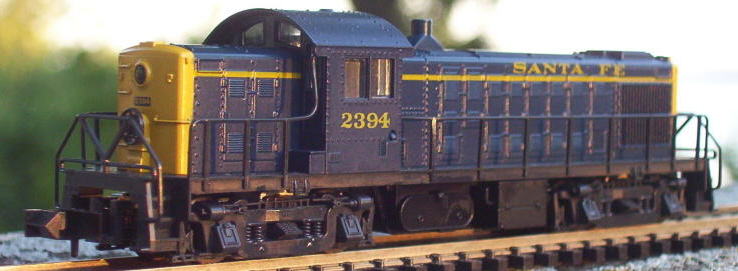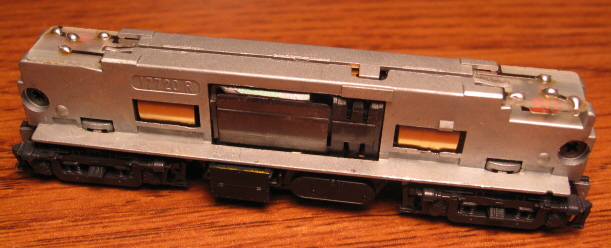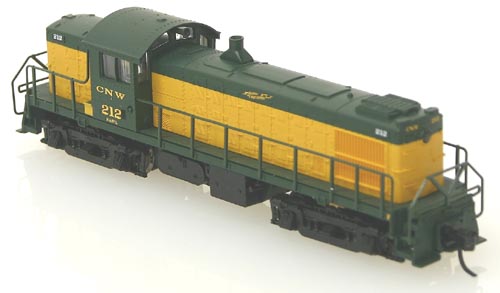

Introduced: 1988 (Kato-made version), 1998 (Chinese-made "Atlas Classic" version), and 2003 (Slow-Speed Motor version)
This was the first Atlas/Kato diesel since their 1983 RS-3 to employ an all-new chassis/mechanism. And it represented a major evolution for the Atlas/Kato line of N scale diesels, at least insofar as it introduced flywheels into the mix - a feature that Kato had (probably non-coincidentally) just made available in their Kato-USA GP38-2 model of the previous year.

Other features include a split-frame metal chassis, split-frame metal truck assemblies, blackened wheels, all-wheel drive (no traction tires), and all-wheel pick-up. The motor is a closed-sided 5-poler. All gearing is plastic. Directional lighting is provided by PC boards mounted on either end of the chassis. The couplers are truck-mounted Rapidos (open pilots). Wheels are low-profile and have no problems on Code-55 track.
Performance on these models is most excellent. They run smoothly and quietly at all throttle levels. Pickup is flawless, slow-speed creep is superb, and pulling power is impressive. The top-end speed is a bit high, but that's a minor nitpick. And running characteristics aside, these things just flat-out look great (especially as compared to other 1980's diesel models).
Atlas severed their ties with Kato in the mid-90s, and in 1998 released this locomotive under their "Atlas Classic" line, (redesigned, retooled, Chinese-manufactured remakes of the locomotives they originally contracted Kato to make for them) -


These models have a new shell and a new chassis. The old metal truck assemblies are replaced by plastic ones (with current collected via metal axle-cups and transferred to the chassis via flexible brass contact strips). The truck-mounted couplers are upgraded to shell-mounts (still Rapidos, though). And as nice as the earlier Kato-made units ran, these run even better (just a little smoother and quieter).

In 2003, a new Atlas Classic version of the RS-1 was issued. New features include -
- Separately-applied painted handrails (where appropriate)
- Slower scale speed motor
- Factory-installed AccuMate magnetic knuckle couplers
As of this writing, Atlas has yet to release a DCC-Ready version of this model (although I'm sure it's only a matter of time before they do).
Trivia - it is reportedly possible to mount an old Atlas/Kato RS-1 shell on the newer Atlas Classic chassis. Unfortunately, the walkways will not swap, so you'll need to keep the one that came with the Atlas Classic shell.
Removing the shell requires a bit of patience and a gentle hand (IE, leave the elbow grease at home). I use a small screwdriver to pry the shell away from the chassis a little bit at a time (starting at one end and working my way around). Eventually it'll slide up and off.
Grade: A (all versions)
Kato-made version reviewed: 3/89 Railroad Model Craftsman, 11/88 Model Railroader: ("This Atlas RS-1 diesel is another fine locomotive made in Japan by Kato. It's a superb model combining good looks with an excellent dual-flywheel mechanism for top performance. The model comes with glazing in the cab windows, Rapido-type couplers, and operating headlights. Like other Atlas locomotives made by Kato, the RS-1 has a highly detailed injection-molded styrene body, cab, and fuel tank. The steps, walkways, and handrails are made as a one-piece assembly that's cast in a tough flexible black plastic. Both trucks have molded sideframes made of the same material and come in friction-bearing or roller-bearing versions. There are no shortcomings in this model's proportions. Its dimensions compare almost perfectly with those shown in prototype RS-1 drawings...
"Mechanically, the RS-1 is similar to earlier models, though some improvements have been made. The chassis consists of two zinc-alloy halves that are separated electrically. A double-shaft open-frame motor sits in the middle of the chassis, with flywheels mounted at each end. Each flywheel has a new universal coupling, which transmits torque to the worm assemblies at the ends. Those assemblies are mounted on the chassis with individual bearings and thrust washers to cut down on vibration and noise as well as to improve operation. Gears in each truck transmit the worm gear's motion to the axles. The wheelsets are blackened, and electrical wipers pick up power from all 8 wheels. When our sample was placed on the rails, it performed perfectly throughout its speed range. It started and continued running smoothly at less than scale 5 MPH - perfect for any switching job. The midrange speed is just about right for a prototype RS1's top speed, while the model's top speed exceeds any normal locomotive's capabilities... The painting has been done neatly, and the printed lettering, heralds and fine yellow striping were first-rate... The model's only real flaw is the lack of pilots, caused by Kato's using truck-mounted Rapido-type couplers... Overall, this is a fine model that will fit any layout set between the early 1940s and the present. Undec, SF, PRR, Soo, B&O, NH, GM&O, SP&S, Amtrak, Southern, GN. Price to be announced")